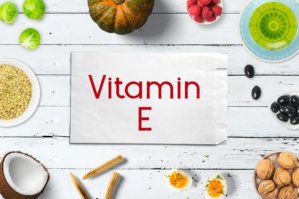About vitamin E: Natural alfa-tocopherol
 Professor Maret Traber from the Linus Pauling Institute in the United States has studied vitamin E for a number of years. Traber, in a review article, looked at the most recent science concerning this important, lipid-soluble nutrient. Judging from her work, it looks as if we only need the form of vitamin E called alfa-tocopherol.
Professor Maret Traber from the Linus Pauling Institute in the United States has studied vitamin E for a number of years. Traber, in a review article, looked at the most recent science concerning this important, lipid-soluble nutrient. Judging from her work, it looks as if we only need the form of vitamin E called alfa-tocopherol.
Vitamin E comes as either tocopherols or tocotrienols, and there are several kinds. Science has identified four different tocopherols (alfa, beta, gamma, and delta) and four different tocotrienols (alfa, beta, gamma, and delta). In total, there are eight kinds of vitamin E. Plants are able to convert one form of vitamin E to another, while animals and humans are not able to do this.
The body prefers natural alfa-tocopherol
All forms of vitamin E are able to counteract the symptoms of vitamin E deficiency, at least to some extent. However, their biological activity differs widely. The body prefers natural alpha-tocopherol, which is the only form of vitamin E with a specific transport gene.
Alfa-tocopherol – the most potent antioxidant
The different types of vitamin E have approximately the same antioxidant activity, but alpha-tocopherol is the most potent of all. The different forms of vitamin E have widely different biological functions. For example, natural vitamin E is two times more biologically active than synthetic vitamin E. In the case that you ingest synthetic alfa-tocopherol, which contains a blend of synthetic and natural tocopherol, the body will attempt to increase its excretion of the “non-usable”, synthetic part of the vitamin.
The role of vitamin E
Vitamin E’s primary role is to protect the long-chained poly-unsaturated fatty acids (PUFAs) against lipid peroxidation. It is therefore plausible that vitamin E protects the essential omega-3 fatty acid, DHA, from fish.
Mixed tocopherols
If you ingest a blend of different vitamin E forms, the liver sorts them and returns all alfa-tocopherol to the blood. Any form that is not alfa-tocopherol is broken down and excreted.
Alfa-tocopherol is the form of vitamin E that is the most effective and the safest for consumption.
Used vitamin E (i.e. when it is destroyed by free radicals) becomes a potentially harmful and relatively long-lived atocopheroxyl free radical, but the water-soluble nutrient vitamin C can repair it. Other forms of vitamin E become more reactive, once they are converted into free radicals, and they may even become toxic to cells. The body has no specific mechanisms for speedy removal of alfa-tocopherol. In contrast, these mechanisms exist for the other forms of tocopherol.
Vitamin E uptake
Vitamin E is absorbed by the enterocytes (intestinal cells) of the mucosa in the small intestine. How exactly this happens has not yet been mapped out, but the absorption is best with the presence of dietary fat. Reduced fat uptake from the intestine automatically impairs the uptake of vitamin E. The same is the case with an impaired ability to produce the lipoproteins that
carry lipids, cholesterol, and vitamin E to different parts of the body.
Having sufficient amounts of bile acid is more important for the uptake of vitamin E than having enough lipid-digestive enzymes. The structure of vitamin E may also influence the absorption of the nutrient. There is reason to believe that vitamin E’s solubility in the intestine is more important than how much vitamin E you consume, when it comes to how well the nutrient is absorbed in the gut.
So-called chylomicrons carry vitamin E from the intestine to the liver by way of the body’s lymph and blood vessels. The different forms of vitamin E appear to be broken down and excreted rather fast, apart from alfa-tocopherol. It stays in the system. Studies show that the body breaks down 100 times more gamma-tocopherol than alfa-tocopherol in mg. A large part of synthetic vitamin E is broken and down and excreted rather fast.
The body controls its own vitamin levels
The liver has two different mechanisms for controlling the body’s vitamin E levels. One system controls the uptake, synthesis and excretion of lipoproteins, while the other is the detoxifying liver function that works by means of detoxifying enzymes called cytochrome P450.
Evidence strongly suggest that the body recognized alfa-tocopherol as a vitamin, whereas even low concentrations of other kinds of vitamin E are treated as “foreign substance”, which the body breaks down and gets rid of.
It is therefore natural alfa-tocopherol, which the liver dispatches to the body’s cells by means of special transport proteins called a-TTP. The liver also synthesizes cholesterol that is carried throughout the body with different transport proteins. These transport proteins also contain alfa-tocopherol to prevent cholesterol from oxidizing.
- VLDL cholesterol particles contain approx. 65 alfa-tocopherol molecules each
- LDL cholesterol particles contain approx. 8-12 alfa-tocopherol molecules each
- HDL cholesterol particles contain less than 1 alfa-tocopherol molecule each
VLDL cholesterol is very dependent on a sufficient supply of alfa-tocopherol from the liver to prevent the cholesterol from oxidizing.
Other vitamin E effects
A study from 1993 (Women’s Health Study) showed that supplementing with alfa-tocopherol lowers the rate of venous thrombosis, a blood clot in a vein deep inside the body (typically in the legs). Vitamin E works by preventing vitamin K’s coagulation mechanism.
No risk of overdosing
If you ingest high quantities of alfa-tocopherol, the liver regulates blood
levels of the nutrient in such a way that it is never higher than two to four times its normal level. In contrast to both vitamin A and D, vitamin E can never accumulate to potentially toxic levels in the liver and other tissues.
Few and probably harmless side effect
The seemingly negative effects of vitamin E that are reported from time to time have been discussed by experts, because the alleged side effects can not necessarily be pinned to vitamin E.
Increased bleeding is the only side effect, which toxicologists can link to ingestion of large quantities of vitamin E. This side effect most likely occurs because vitamin E inhibits vitamin K.
Measuring vitamin K
Blood levels of vitamin E do not represent a reliable method for measuring a person’s vitamin E status. In fact, with people who either have to little or too much fat in their blood, blood levels of vitamin E give a very inaccurate picture. The most reliable way to assess the body’s vitamin E status is to measure the amount of vitamin E metabolites in the urine.
Conclusion
Maret Trabers review article refutes earlier reports of problems with overdosing from vitamin E supplements. It also questions the benefits of taking other forms of vitamin E than alfa-tocopherol.
Ref.
Traber MG. Mechanisms for the Prevention of Vitamin E Excess. J Lipid Res 2013. E-pub ahead of print.
- Created on .












 "After about one week of taking the Q10 supplement I could feel a huge difference," says 23-year old Alan Piccini, who has been suffering from extreme fatigue and muscle aches ever since he was a child.
"After about one week of taking the Q10 supplement I could feel a huge difference," says 23-year old Alan Piccini, who has been suffering from extreme fatigue and muscle aches ever since he was a child. “Taking capsules with co-enzyme Q10 has freed me of the severe side effects of my cholesterol lowering medicine,” Mrs Franken explains.
“Taking capsules with co-enzyme Q10 has freed me of the severe side effects of my cholesterol lowering medicine,” Mrs Franken explains.